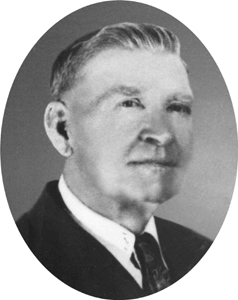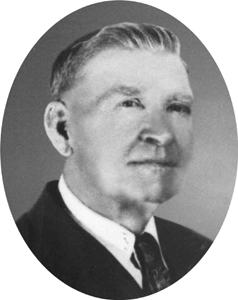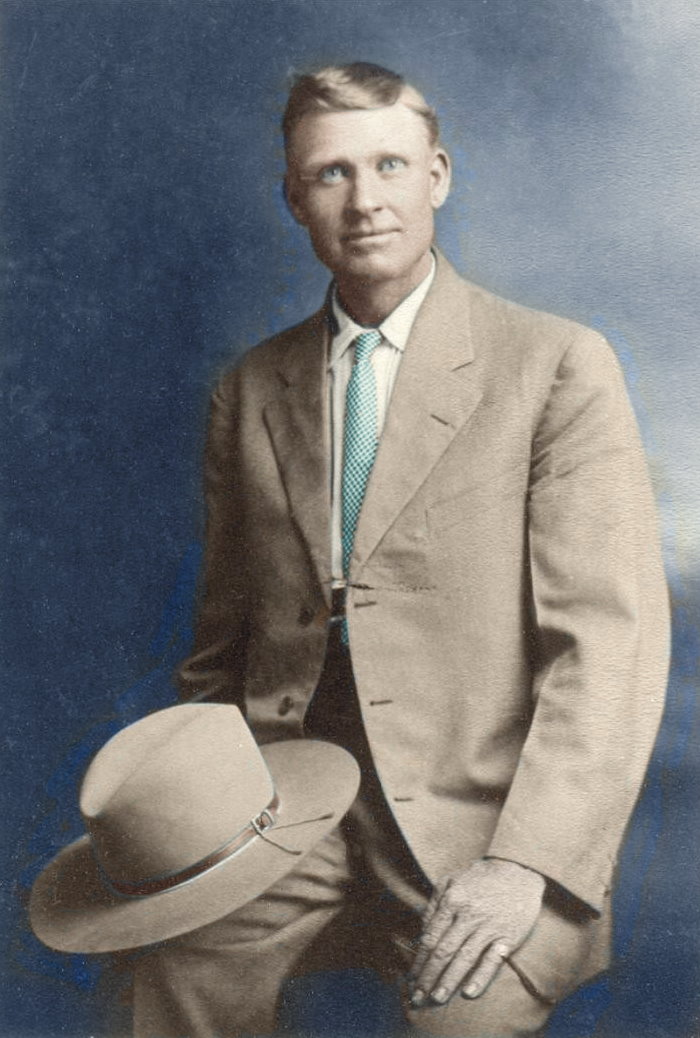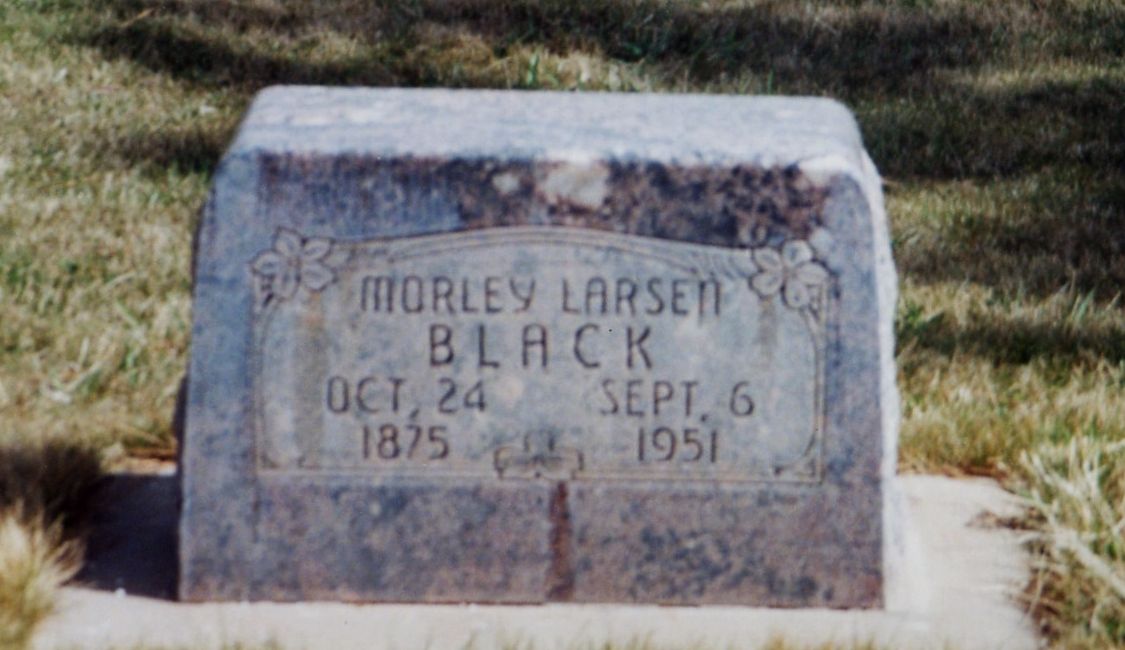Birth: 10/24/1875
Death: 9/6/1951
Burial: 9/8/1951
Place of Birth: Orderville, Kane, Ut
Place of Death: Blanding, San Juan, Ut
Cause of Death: Cancer
Grave Location: Blanding City Cemetery, 1_54_1_6
Source: Sexton Records / Grant
Comments:
Relatives: Porter, Nellie (Spouse)
Morley Larsen Black was born on the 24th of October 1875 in Orderville, Kane County, Utah to William Morley Black and Maria Hansen.
Morley Larsen Black's Family lived the United Order at Orderville, Utah. This is where Church members lived in a common community and shared talents, materials and duties.
Morley Larsen Black had scarlet fever as a baby and survived.
When Morley Larsen Black was 8 years old his Family moved to Huntington, Utah. William Morley had his Family living on forty acres of land and herded cattle.
Morley Larsen loved racing horses and was one of the main jockeys.
Morley went on a trip with his Brother to Mancos, Colorado.
Morley Larsen Black moved to with his Father William Morley Black to Mexico in the 1890s. William Morley arrived in Colonia Diaz, Mexico on the 4th of June 1889. The U.S. Marshalls were constantly after William Morley because he had a number of wives.
Morley Larsen lived in several places before settling in Cave Valley, Chihuahua, Mexico.
He was married to Lydia Ellen (Nellie) Porter on the 26th of October 1896 in Cave Valley, Galeana, Chihuahua, Mexico.
Morley Larsen worked at a saw mill doing freighting and most anything he could get to do.
Morley Larsen and Nellie lived in a two or three room large frame house. He worked for Nellie's father Warriner Ahaz Porter making shingles at a mill. The Black and Porter families were excellent sawmill operators.
Morley Larsen and Nellie moved to Cave Valley, Mexico where they lived on a ranch owned by Moses Thatcher. Moses Thatcher helped the LDS members in Mexico and later became a member of the Council of Twelve Apostles for the LDS Church.
Morley Larsen loved living in Mexico. He tells of the beautiful fields of flowers in which he would ride his horses. The flowers grew up as tall as the shoulders of the horses. He met Rachel Lunt at this time and went back to Pacheco to stay for several years.
Morley Larsen was called on a Mission for the LDS Church to Mexico City from 1905 and 1906. He learned to speak excellent Spanish. During this time Nellie built an extra room onto their home with the help of neighbors.
Morley Larsen moved to Pearson after he returned from his Mission to Mexico, City. There was a large electric sawmill owned by a British sawmill Company, Pearon. At the sawmill Morley Larsen was the Supervisor over a large number of locals because of his excellent communication abilities in Spanish. He was the chief night watchman at the Pearson Sawmill.
There was some fear of reprisal at the Pearson Sawmill because of the Mexican Revolution. Morley Larsen said the Mexican Revolution was very difficult. There were a number of groups fighting including first the Federals, the Viestes, then Salazar and his bunch of Red Flaggers.
On the 28th of July 1912 the LDS Stake President Junnius Romney sent messengers to the Mormon settlements advising them to get out of Mexico immediately. On Wednesday the 31st of September 1912, Nellie and Family ;were loaded on train cars at Pearson bound for El Paso. They took only a trunk of cloths and a little bedding thinking they would return soon. Most of the American colonists who left Mexico did not return because of the fighting. Morley Larsen returned to Mexico to be with Rachel Lunt's Family. He loved Mexico and did not want to leave. He always thought the Revolution would be over soon.
LeGrand was born on the 24th of September 1912. Morley thought it best that Nellie leave Mexico to the United States for her protection and her young children. In October 1912 after LeGrand was three weeks old Nellie boarded a train for El Paso. The refugees stayed at a lumber yard in El Paso. Nellie returned with her Father Warner Ahaz by Train to Utah where she eventually settled in Blanding. The son and daughters who went with Nellie included; William, Ivy, Perry, Reva, Jose, Orin and baby LeGrand.
Morley Larsen stayed in Mexico with Aunt Rachel's Family. He continued to work at the lumber mill. On the 9th of June 1913, Morley was shot at by some of Pancho Villa's men. He escaped by way of a ditch by the sawmill. Morley Larsen recalls he took off his belt and his gun, wrapped them in a red handkerchief and hid them in a hole under a rock. Morley Larsen returned later to dublan to see if the revolution had quieted down. The Revolution was still going and Morley Larsen sold his Mexican property to Bert Whetton in return for a logging wagon. Morley Larsen, Rachel and her children returned back to Blanding from Mexico in 1913.
In 1913 Morley Larsen arrived in Blanding to see his wife Nellie. He moved his wife Rachel and her family to a home near the sawmill in Blanding. Nellie and her children lived in a simple wood house near Westwater Canyon at Blanding, Utah.
Morley Larsen and his Brother Dave took a contract hauling logs by wagon to the sawmill. They used bobsleds in the Winter to haul wood. Morley Larsen moved to a dry farm in Devil Canyon near Monticello with his two families and 11 children. Morley Larsen raised Sudan grass which grew taller than a man. Morley Larsen had 40 bushels of wheat to an acre, oats, potatoes and eight horses. Morley Larsen said it was a struggle to get one cow for Nellie's Family and one cow for Rachel's Family. Morley Larsen said he would hire himself out with two or three teams of horses. He would use his small sons for slip drives. His son LeGrand mentions how he helped on these wagon teams.
Times were rough in Blanding. LeGrand mentions how his Mother Nellie's house in Blanding had broken windows. LeGrand said he would place paper on the windows to keep the cold wind out. LeGrand said they did not have much milk and he would squeeze the milk out of the bread so they could have more.
It was very difficult for Morley Larsen to support two families with 24 children. Morley Larsen loved horses. This was a diversion for him. He liked to watch, participate and sometimes bet on the horse races Rachel's and Nellie's children associated with each other with respect and high regard through-out their lives.
Even though the families lived in poverty they espoused values of work , industry, love for family and community service. All of these can be seen in how successful each family member has become.
In 1926 Nellie decided to move from Blanding to Salt Lake City. She loaded up her children and had her young
son Orin drive in an old car from Blanding to Salt Lake City. The car broke down on the way, but they arrived first in Salt Lake to stay with Nellie's Daughter Ivy. Nellie and her Family eventually settled in a small home between two railroad tracks in Sandy, Utah. She eventually got a divorce from Morley Larsen.
Nellie and Morley Larsen always had a special love for each other. Morley Larsen would still visit her at times. It was though they knew things would not work out, but they still cared deeply about each other. They had been through so much. Sometimes love defies great odds.
Lydia Ellen (Nellie) Porter Black died on the 25th of July 1939 in Salt Lake City, Utah. She was buried in the Sandy Cemetery, Sandy, Utah. She had carded wool when younger and this may have given her pulmonary problems. Her son Guss said she waited until Morley Larsen Black arrived before she died.
Morley Larsen Black died on the 6th of September 1951 in Blanding, Utah of Cancer on Sept. 8, 1951 at Blanding Cemetery, San Juan County, Utah. He was buried in the Blanding City Cemetery.
For Many years Morley Larsen's wagon was displayed at the Gateway Motel in Blanding, Utah.
His love for horses could be seen in his sons' love for horses. Both Orin Black and Gus Black loved to ride horses and enter them in contests and won many awards.
Birth: 10/24/1875
Death: 9/6/1951
Burial: 9/8/1951
Place of Birth: Orderville, Kane, Ut
Place of Death: Blanding, San Juan, Ut
Cause of Death: Cancer
Grave Location: Blanding City Cemetery, 1_54_1_6
Source: Sexton Records / Grant
Comments:
Relatives: Porter, Nellie (Spouse)
Morley Larsen Black was born on the 24th of October 1875 in Orderville, Kane County, Utah to William Morley Black and Maria Hansen.
Morley Larsen Black's Family lived the United Order at Orderville, Utah. This is where Church members lived in a common community and shared talents, materials and duties.
Morley Larsen Black had scarlet fever as a baby and survived.
When Morley Larsen Black was 8 years old his Family moved to Huntington, Utah. William Morley had his Family living on forty acres of land and herded cattle.
Morley Larsen loved racing horses and was one of the main jockeys.
Morley went on a trip with his Brother to Mancos, Colorado.
Morley Larsen Black moved to with his Father William Morley Black to Mexico in the 1890s. William Morley arrived in Colonia Diaz, Mexico on the 4th of June 1889. The U.S. Marshalls were constantly after William Morley because he had a number of wives.
Morley Larsen lived in several places before settling in Cave Valley, Chihuahua, Mexico.
He was married to Lydia Ellen (Nellie) Porter on the 26th of October 1896 in Cave Valley, Galeana, Chihuahua, Mexico.
Morley Larsen worked at a saw mill doing freighting and most anything he could get to do.
Morley Larsen and Nellie lived in a two or three room large frame house. He worked for Nellie's father Warriner Ahaz Porter making shingles at a mill. The Black and Porter families were excellent sawmill operators.
Morley Larsen and Nellie moved to Cave Valley, Mexico where they lived on a ranch owned by Moses Thatcher. Moses Thatcher helped the LDS members in Mexico and later became a member of the Council of Twelve Apostles for the LDS Church.
Morley Larsen loved living in Mexico. He tells of the beautiful fields of flowers in which he would ride his horses. The flowers grew up as tall as the shoulders of the horses. He met Rachel Lunt at this time and went back to Pacheco to stay for several years.
Morley Larsen was called on a Mission for the LDS Church to Mexico City from 1905 and 1906. He learned to speak excellent Spanish. During this time Nellie built an extra room onto their home with the help of neighbors.
Morley Larsen moved to Pearson after he returned from his Mission to Mexico, City. There was a large electric sawmill owned by a British sawmill Company, Pearon. At the sawmill Morley Larsen was the Supervisor over a large number of locals because of his excellent communication abilities in Spanish. He was the chief night watchman at the Pearson Sawmill.
There was some fear of reprisal at the Pearson Sawmill because of the Mexican Revolution. Morley Larsen said the Mexican Revolution was very difficult. There were a number of groups fighting including first the Federals, the Viestes, then Salazar and his bunch of Red Flaggers.
On the 28th of July 1912 the LDS Stake President Junnius Romney sent messengers to the Mormon settlements advising them to get out of Mexico immediately. On Wednesday the 31st of September 1912, Nellie and Family ;were loaded on train cars at Pearson bound for El Paso. They took only a trunk of cloths and a little bedding thinking they would return soon. Most of the American colonists who left Mexico did not return because of the fighting. Morley Larsen returned to Mexico to be with Rachel Lunt's Family. He loved Mexico and did not want to leave. He always thought the Revolution would be over soon.
LeGrand was born on the 24th of September 1912. Morley thought it best that Nellie leave Mexico to the United States for her protection and her young children. In October 1912 after LeGrand was three weeks old Nellie boarded a train for El Paso. The refugees stayed at a lumber yard in El Paso. Nellie returned with her Father Warner Ahaz by Train to Utah where she eventually settled in Blanding. The son and daughters who went with Nellie included; William, Ivy, Perry, Reva, Jose, Orin and baby LeGrand.
Morley Larsen stayed in Mexico with Aunt Rachel's Family. He continued to work at the lumber mill. On the 9th of June 1913, Morley was shot at by some of Pancho Villa's men. He escaped by way of a ditch by the sawmill. Morley Larsen recalls he took off his belt and his gun, wrapped them in a red handkerchief and hid them in a hole under a rock. Morley Larsen returned later to dublan to see if the revolution had quieted down. The Revolution was still going and Morley Larsen sold his Mexican property to Bert Whetton in return for a logging wagon. Morley Larsen, Rachel and her children returned back to Blanding from Mexico in 1913.
In 1913 Morley Larsen arrived in Blanding to see his wife Nellie. He moved his wife Rachel and her family to a home near the sawmill in Blanding. Nellie and her children lived in a simple wood house near Westwater Canyon at Blanding, Utah.
Morley Larsen and his Brother Dave took a contract hauling logs by wagon to the sawmill. They used bobsleds in the Winter to haul wood. Morley Larsen moved to a dry farm in Devil Canyon near Monticello with his two families and 11 children. Morley Larsen raised Sudan grass which grew taller than a man. Morley Larsen had 40 bushels of wheat to an acre, oats, potatoes and eight horses. Morley Larsen said it was a struggle to get one cow for Nellie's Family and one cow for Rachel's Family. Morley Larsen said he would hire himself out with two or three teams of horses. He would use his small sons for slip drives. His son LeGrand mentions how he helped on these wagon teams.
Times were rough in Blanding. LeGrand mentions how his Mother Nellie's house in Blanding had broken windows. LeGrand said he would place paper on the windows to keep the cold wind out. LeGrand said they did not have much milk and he would squeeze the milk out of the bread so they could have more.
It was very difficult for Morley Larsen to support two families with 24 children. Morley Larsen loved horses. This was a diversion for him. He liked to watch, participate and sometimes bet on the horse races Rachel's and Nellie's children associated with each other with respect and high regard through-out their lives.
Even though the families lived in poverty they espoused values of work , industry, love for family and community service. All of these can be seen in how successful each family member has become.
In 1926 Nellie decided to move from Blanding to Salt Lake City. She loaded up her children and had her young
son Orin drive in an old car from Blanding to Salt Lake City. The car broke down on the way, but they arrived first in Salt Lake to stay with Nellie's Daughter Ivy. Nellie and her Family eventually settled in a small home between two railroad tracks in Sandy, Utah. She eventually got a divorce from Morley Larsen.
Nellie and Morley Larsen always had a special love for each other. Morley Larsen would still visit her at times. It was though they knew things would not work out, but they still cared deeply about each other. They had been through so much. Sometimes love defies great odds.
Lydia Ellen (Nellie) Porter Black died on the 25th of July 1939 in Salt Lake City, Utah. She was buried in the Sandy Cemetery, Sandy, Utah. She had carded wool when younger and this may have given her pulmonary problems. Her son Guss said she waited until Morley Larsen Black arrived before she died.
Morley Larsen Black died on the 6th of September 1951 in Blanding, Utah of Cancer on Sept. 8, 1951 at Blanding Cemetery, San Juan County, Utah. He was buried in the Blanding City Cemetery.
For Many years Morley Larsen's wagon was displayed at the Gateway Motel in Blanding, Utah.
His love for horses could be seen in his sons' love for horses. Both Orin Black and Gus Black loved to ride horses and enter them in contests and won many awards.
Family Members
-
![]()
Joseph Andrew Black
1861–1940
-
![]()
Rachel Ann Black Porter
1863–1906
-
![]()
Olive Myrtle Black Palmer
1865–1949
-
William Sanford Black
1867–1868
-
![]()
Miller Snow Black
1869–1953
-
![]()
Harriet Drucilla Black Guymon
1871–1965
-
![]()
David Patten Black
1874–1958
-
![]()
Ablonne Black Chapple
1880–1959
-
Mary Elizabeth Black
1846–1847
-
![]()
Martin Luther Black
1848–1918
-
![]()
Martha Jane Black Gale
1849–1921
-
![]()
Tamar Jane Black Young
1852–1915
-
Sarah Emma "Olive" Black
1853–1853
-
William Kimball Black
1854–1856
-
![]()
Sarah Amelia Black Young
1854–1950
-
![]()
John Morley Black
1856–1933
-
![]()
Isaac Edwin Black
1857–1931
-
![]()
William Grant Black
1857–1948
-
![]()
Benjamin Daniel Black
1859–1945
-
![]()
Mary Ann Black Palmer
1861–1880
-
![]()
George Henry Black
1861–1923
-
Daniel Wells Black
1862–1865
-
![]()
Charles Theodore Black
1864–1924
-
![]()
Eva Minerva Black Palmer
1866–1950
-
![]()
Margaret Ellen "Maggie" Black Rowley
1869–1961
-
![]()
William Washburn Black
1870–1884
-
![]()
Orson Pratt Black
1871–1946
-
![]()
Catharine Amelia Black
1873–1873
-
![]()
Parley Pratt Black
1875–1948
-
![]()
Mary Belle Black Carroll
1875–1955
-
![]()
Calista Black Peel
1876–1955
-
![]()
Amy Jane Black Carroll
1877–1959
-
![]()
Etta Clarinda "Clara" Black Webb
1880–1966
-
Eliza Roxie Black
1880–1891
-
![]()
Edward Webb Black
1881–1958
-
Lewis Almon Black
1884–1884
-
![]()
Lula Lorraine Black Drummond
1885–1968
-
![]()
Ella Civilla Black Talley
1888–1926
-
![]()
Junius Exile Black
1893–1977
-
![]()
William Morley "Bill" Black
1897–1952
-
![]()
Ivy Mariah Black Brockbank
1898–1965
-
![]()
Perry Warner Black
1900–1984
-
Lione Black
1902–1903
-
Henry Black
1902–1904
-
![]()
Reva Mary Black Kirby
1905–1992
-
![]()
Reta Black Johnson
1905–1998
-
Alberto Black
1907–1907
-
![]()
Jose Black
1908–1928
-
![]()
Morley Chase Kimball "Kimball" Black
1909–1980
-
![]()
Orin Porter Black
1910–2004
-
![]()
Glendon Black
1911–2003
-
![]()
LeGrand Black
1912–2002
-
![]()
William Lunt Black
1913–1977
-
![]()
Kline Black
1915–1995
-
![]()
Guss Porter Black
1915–2008
-
![]()
Fonda Porter Black
1917–1928
-
![]()
Carma Black Billings
1917–1997
-
![]()
Kelly Darnell Black
1920–2003
-
![]()
Dall Larsen Black
1922–2004
-
![]()
Darlene Black Billings
1922–2012
-
![]()
Myrtle Ann Black Johnson
1925–1975
-
Rex J Black
1927–1928
-
![]()
Rachel "Toots" Black
1927–2015
Sponsored by Ancestry
Advertisement
Records on Ancestry
Sponsored by Ancestry
Advertisement






























































